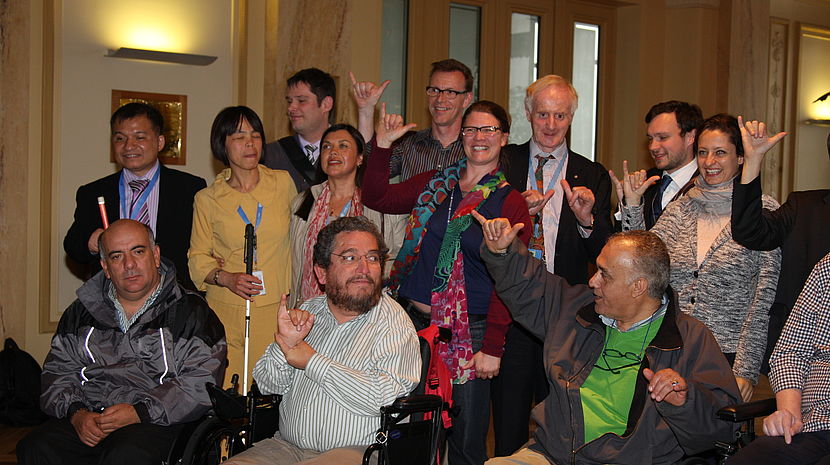Human Rights Protection for women and girls with disabilities

At a CRPD Committee meeting, members sign 'YES' to inclusion
“It would be great to see all of the UN human rights treaty bodies address the issues faced by women and girls with disabilities and that it is not kept in a silo, but is a crosscutting issue” . Diane Kingston OBE, Deputy Director of CBM’s International Advocacy and Alliances and Expert Member of the CRPD Committee on the Rights of Persons with Disabilities talks to CBM about how the CRPD committee is developing a General Comment on the rights of women and girls with disabilities.
Can you start with telling us why the CRPD committee felt it was important to have a General Comment on women and girls with disabilities?
When I joined the Committee a decision had already been taken to develop a General Comment on Article 6 on women and girls with disabilities. I joined when the half ‘day of general discussion’ took place with the public in Geneva on 16th April 2013. I thought ‘I want to be part of that Working Group, that’s a really important subject’.
What is a General Comment?
A General Comment is specific guidance for States Parties who have ratified the Convention on how to actually implement a specific Article that may not be well understood. The reason why Article 6 has been chosen for a General Comment is because women and girls with disabilities have been neglected in international and national laws and policy. Most disability policy has been put in place for male war veterans and issues facing women and girls with disabilities were not visible. There was a real need to address the specific needs of women and girls with disabilities. Of course women with disabilities had been organising themselves long before the Convention was negotiated.
There has been different types of equality promotion and non-discrimination in various human rights treaties dating right back to 1948, with the Universal Declaration on Human Rights. However, nothing really specifically on women with disabilities had been developed, and so Article 6 is the first binding instrument in human rights law, which outlaws discrimination based on disability and gender. So this is really key for us to be able to transform the lives of women and girls with disabilities.
What topics influenced the development of the General Comment on Article 6?
Firstly, the Convention Committee Members observed that there were a number of elements that kept appearing in States Parties’ reports, these were: violence against women and girls with disabilities (specifically sexual violence) sexual and reproductive rights and intersectionality - where gender and disability combine together resulting in multiple discrimination. This led to a half-day of general discussion on women and girls with disabilities, where civil society, governments and other interested parties could present oral and written submissions to the Committee. On the basis of the submissions, a small Working Group, chaired by Ana Pelaez and co-Chaired by Theresia Degener, then took analysed the content and began to draft the General Comment on how to implement Article 6.
Can tell about what will be covered under the three key topics you have highlighted?
Yes, in terms of violence against women and girls with disabilities, the General Comment will cover: family violence, violence within the community and State violence including State-run institutions. In terms of sexual and reproductive rights: forced sterilization, forced contraception, parenting, mother and child protection. In the third area of intersectionality, it will focus on the multiple forms of discrimination and how they intersect e.g. women, disability, age ethnicity etc. Another aspect of the General Comment is that a States Parties that has ratified the Convention will have an immediate obligation to implement Article 6 as non-discrimination is not something that can be progressively realized.
We will also be looking to States Parties to ensure that they have well planned consultations with women and girls with disabilities and their organisations. There will also be guidance on how Article 6 inter-relates to other Articles in the Convention. For example: Article 9 on accessibility, urban design around the needs of women and girls with disabilities; Article 11 on humanitarian emergencies, women and girls with disabilities are more at risk in terms of conflict and war; Article 12 and legal capacity (particularly choice about bodily integrity); Article 19, women choosing where they want to live and who they live with; Article 24 on education, attendance and trying to combat negative stereotypes Article 27 on employment, women with disabilities are less likely to be employed than men without and without disabilities; and Article 32 and the real needs to address the inclusion of women and girls with disabilities to make sure they are included in development aid and international development programmes.
Did the Committee link with mainstream women’s organisations?
We are very proud that this Working Group very outset said that we want to work in a real interagency manner with as many stakeholders as possible. So in the earliest stages we had a conference with a number of UN agencies and bodies e.g. WHO and their committee on reproductive rights; UN women, we also invited the women’s rights committee CEDAW and the child rights committee (UNCRC) and UNFPA. It is a multi stakeholder approach, we feel that we have buy-in from key agencies that can make a difference with implementation. We found many areas we agree on and of course there are areas where we disagree, but are working towards a consensus.
What are the next steps?
The Committee will be meeting in March and April where we will hopefully agree the final timeline. It would be great if it could be available for online consultation later this year, which is open to the public.
For more details on the CRPD committee, read here.